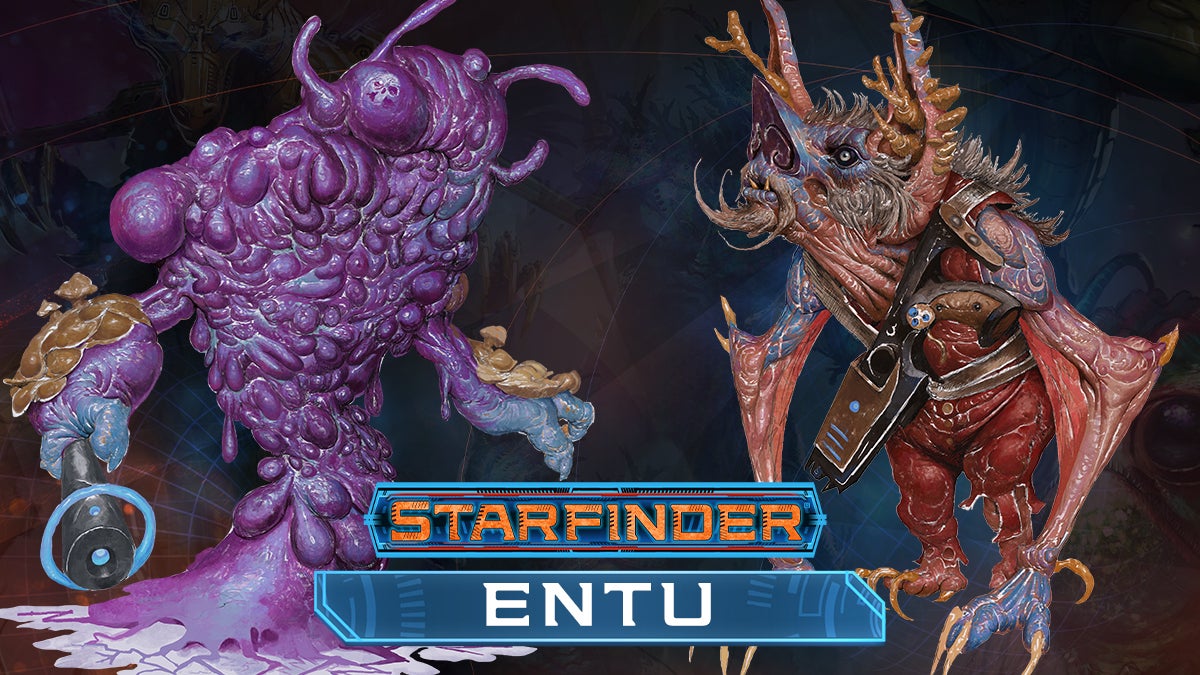The Starfinder Roleplaying Game is both weird and wonderful. So, even though the Holiday season is upon us—or perhaps because of it—we present to you the full fungus entry from the new Starfinder Alien Archive 4 to battle, befriend or become. Introducing the entu colony!

Entu Colony
Entu colonies begin their life cycle as a collection of minuscule spores. Over time, the spores fuse together through intricate networks of mycelia that function similarly to neurons, creating sapient and mobile fungal colonies. These structures generate conscious thought and obtain sensory information about the colony’s environment.
In their first weeks of life, entu spores gradually coalesce into amorphous pools of opalescent slime with malleable pseudopod-like organs. At this stage, colonies can communicate telepathically with other creatures using a lexicon of sensory and emotional concepts. Entu colonies can reproduce asexually once they reach maturity, typically six months after they first sprout mycelia. Most of the resulting spores integrate into the parent colony, but some may split off to form a separate colony.
Thought not parasitic, entu colonies feed on emotion and thought. In fact, some seek to consensually merge with other sentient creatures rather than form into full-fledged and independent colonies. Instead of harming their host, an entu fungus’s adaptable cells mimic the host’s brain and nerve tissue. Their mycelia intertwine with their host’s central nervous system, creating new synapses and enhancing sections of the host’s brain. Despite inhabiting the host’s body, the entu fungus retains a separate consciousness which intertwines with its host through shared functional memories and sensory input. The resultant symbiotic life-form, called an entu symbiote, eventually attains self-awareness, complex thought, and even linguistic ability. Entu integration can sometimes result in entu symbiotes’ offspring already being seeded with the fungal life integrated into their bodies and brains; this development has led to the “uplifting” of entire species of previously non-sapient animals.
The nelentu, one of the founding species of the Kreiholm Freehold, is a prominent example of a successful symbiosis that spans generations. Originally a species of bat-like animals called neleks that evolved on Agillae-2, these once unintelligent, fruit-eating creatures encountered entu spores early in their evolution and willingly became their hosts. The two species formed a society based on this symbiosis. Today, nelentus inhabit tiered jungle-cities built around green spaces, known as Gardens of Thought, where they cultivate entu spores for future generations. Nelentus consider themselves to be one species, referring to themselves and other nelentus using plural pronouns in deference to their dual nature.
Entu fungi of all kinds seek constant exposure to emotion and thought to thrive, and those involved with symbiotes prioritize their hosts’ physical needs. They prefer to enter symbiotic relationships with creatures who can benefit from their cellular mimicry, living as long as the host creature does—and dying along with it. Entu colonies, on the other hand, can survive for up to 300 years.
The entu are two-playable-races-in-one!
Entu Colonies
Ability Adjustments: +2 Int, +2 Cha, –2 Str
Hit Points: 2
Size and Type: Entu colonies are Small oozes. Amorphous: An entu colony has the amorphous universal creature rule (page 152).
Entu Colony Senses: An entu colony has blindsight (emotion) with a range of 60 feet.
Limited Ooze Benefits: See page 34.
Limited Telepathy: Entu colonies have limited telepathy with a range of 30 feet. Tactical Symbiosis: See page 34.
Entu Symbiotes
Ability Adjustments: +2 Int
Hit Points: 4
Size and Type: Entu symbiotes are Small, Medium, or Large animals with the entu symbiote subtype. Entu Symbiote Senses: An entu symbiote has blindsense (emotion) with a range of 30 feet and low-light vision.
Extrasensory Perception: The mycelia integrated into an entu symbiote’s nervous system allow them to perceive ambient thoughts and emotion. They gain a +2 racial bonus to Perception and Sense Motive checks.
Limited Augmentations: The only augmentations that can be installed in an entu symbiote’s brain are datajacks and the mechanic’s custom rig.
Limited Telepathy: Entu symbiotes have limited telepathy with a range of 30 feet.
Natural Weapons: Entu symbiotes have the natural weapons universal creature rule with a kinetic damage type chosen at character creation.
Symbiotic Enhancement: At character creation, an entu symbiote chooses a fly speed (Ex, average), burrow speed, climb speed, or swim speed, matching thematically the type of animal on which the entu symbiote is based. The entu symbiote has that speed with a value of 20 feet.
The Starfinder Alien Archive 4 Editing Lead was Avi Kool with Editors: Judy Bauer, Gideon F., Leo Glass, Patrick Hurley, Avi Kool, Ianara Natividad, Kieran Newton, and Lu Pellazar.
Don’t miss Part 1 and Part 2 of Aliens Among Us which explore the astriapi, the copaxi, and species grafts. Next week we examine the hadrogaan and more!
Adventures Ahead!